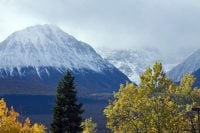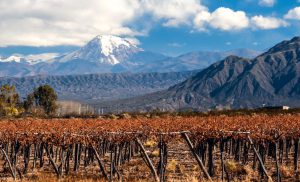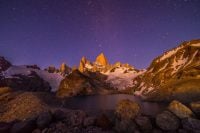Patagonia is as unique as it is vast: a land where chunks of ice the size of double-decker buses break off ancient glaciers and plummet spectacularly into the ocean. It is a rare untamed landscape and location of some of the few remaining uninhabited places on Earth with ecosystems and habitats thriving with wildlife. For a holiday observing wild animals, Patagonia is an unbeatable destination for adventurous travellers seeking new and unique experiences.
Both the Atlantic coast in the east of Argentine Patagonia and the Pacific Ocean, which flows into the fjords in the west of Chile, are brimming with marine wildlife. To witness this for yourself, summer and fall are the best times to visit. Take a cruise to remote wildlife habitats that can’t be reached any other way, or go on a kayak adventure and meander along Charles Darwin’s route through the historic Beagle Channel and witness sea lions, penguin colonies and breeching whales, amidst the rugged landscape of the Tierra del Fuego.
Marine life in Patagonia
Magellanic Penguins
There are more penguins than people in Patagonia. Despite this Patagonian penguins are on the IUCN Red List classified as “Near Threatened” largely due to climate change and over fishing so they have to travel further afield for food and face more predators on their way. Nevertheless, Patagonia is a wonderful place to witness these beautiful and unique creatures with some fascinating habits.
Named after the explorer Ferdinand Magellan, Magellanic penguins are the most plentiful breed of the flightless bird in Patagonia. Endemic to South America, during the breeding season this penguin lives in colonies mainly in southern Chile, but also along the coasts of Argentina, and the Falkland Islands. Penguin watchers should not miss Isla Magdalena: Chile’s Most Important Magellanic Penguin Colony in the Strait of Magellan, the main cruises don’t always stop here so check first.
Blue whales
Spot a blue whale, the largest animal on earth, in the Corcovado Gulf, south of the Chiloe Island archipelago in northern Patagonia. These massive creatures can be seen in the gulf’s waters between January and April, when they nurse their young. Spotting a blue whale, however large they may be, takes patience – sightings are not guaranteed. Whale watching tours offer a good chance with dedicated blue whale watching excursions. They know the best areas and times to sight one of these gentle giants.
Humpback whales
Humpbacks can be spotted in the Francisco Coloane Marine Park is in the Strait of Magellan in Chilean Patagonia. You can only get there by boat and normally visit as part of a longer trip. BUt it’s worth it as these whales are abundant here and sightings are almost guaranteed. Many visitors see around 30–40 to whales on a three-night excursion. The area is also home to orcas – though sightings are less common.
Orcas
The ValdésPeninsula in Argentinian Patagonia is home to two species of whales: orcas and southern right whales. Orcas are here all year round, but the most spectacular sights occur when there are sea lion pups on the shore. These orcas have a famous unique hunting method of beaching themselves in order to catch a sleeping elephant seal or sea lion. A sizable pod of orcas is resident between October and November.
Southern right whales
Southern right whales can be spotted in the Golfo Nuevo and Golfo San Jose during mating season. Running from August–October, southern right whale activity is so commonplace you are almost guaranteed to catch a glimpse from land or by boat. from May to calve and nurse its young. This species remains in the waters off the coast of the peninsula until December. Bottle nose and Commerson’s dolphins are also regularly sighted in these seas.
Elephant seals
Elephant seals inhabit the Valdés Peninsular all year round. The breeding period, from August to early November and most of the pups are born in early October. Breeding season is the best for wildlife watchers, as this species spends most of its time in the water hunting squid during the other months. Colonies of sea lions also lounge on the Valdes Peninsula beaches for most of the year.
Whale watching with Australis
Australis offer one-way and round trips of the Patagonian fjords, where you can spot an abundance of the wild animals of Patagonia. As part of a wider program of excursions, these cruises include whale watching tours. Retracing the steps of Darwin’s route around the straits of Patagonia, travelers have the opportunity to see all the species we mention here. For more information about Australis Patagonia cruises, click here to download our brochure.
Wildlife On Land
A seemingly-barren peninsula on the Atlantic coast close to Puerto Madryn, the Valdes Peninsula is a UNESCO World Heritage nature reserve where visitors can witness myriad species of animals native to Patagonia.
This stretch of land of the Valdés Peninsular is also inhabited by guanaco, armadillos, rheas and gray foxes.
Guanaco
At any time of year, you’re likely to spot the guanaco, a native camelid and close relative of the llama, which isendangered elsewhere, grazing on the grasslands or mountains of Patagonia.
Puma
The elusive puma, the largest predator in Patagonia, is most easily spotted in Tierra del Fuego and the Aisén Regions of Chile, particularly in Torres del Paine National Park.Andean condors patrol through the skies in Torres del Paine and whole groups can be spied feasting on guanacos.
Huemul
The shy, endangered South Andean Deer or huemul also inhabits Torres del Paine and the Bernardo O’Higgins National Park on the border with Argentina. The latter region has a population of around 75 huemul, and it is believed that only around 15,000 individuals remain in the whole continent.
Don’t miss our free guide to the best nature and wildlife destinations.
Bird watching in Patagonia
There is a rich array of wild animals in patagonia but it is also heavenly for bird watchers. It is home to 360 different species of birds, with 40 of these being native to the area and including both marine species and land-dwelling birds. There is fabulous bird watching in Cape Horn, where birders can spot Magellanic and two-banded plovers, Chilean flamingos, White-rumped sandpipers among many others.
Download our free guide to bird watching in Patagonia here.
No comments yet
There are no comments on this post yet.





Leave a comment